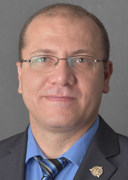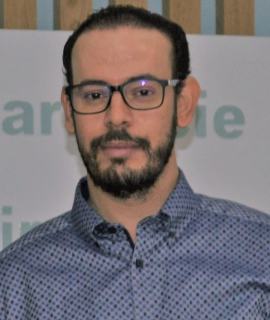Session and Tracks
The dental field is undergoing a transformative shift driven by cutting-edge technologies, clinical advancements, and a deeper understanding of oral-systemic connections. From precision diagnostics to regenerative therapies, today’s breakthroughs are redefining how we approach oral care. Emerging areas such as digital dentistry, AI-assisted diagnostics, 3D printing, and biomaterial science are streamlining procedures and elevating patient outcomes. Regenerative techniques utilizing stem cells and tissue engineering are opening new doors for repairing oral structures and managing complex conditions. Nanotechnology, salivary diagnostics, and minimally invasive treatment methods are enhancing preventive care and therapeutic precision, while sustainable practices are gaining ground across clinical protocols. This evolving landscape offers an exciting platform for clinicians, researchers, and industry leaders to explore new horizons, share findings, and shape the future of oral healthcare. Join us as we spotlight these innovations and foster collaboration for a healthier, more technologically advanced tomorrow in dentistry. As researchers and clinicians continue to bridge the gap between laboratory discoveries and chairside applications, the field is witnessing a transformation that emphasizes evidence-based practice, sustainability, and patient-centred care. These evolving approaches reflect a commitment to not only treating oral conditions but also enhancing overall health and quality of life through innovative dental practices.
Restorative dentistry plays a vital role in re-establishing both the function and appearance of the dentition affected by decay, trauma, or wear. With continual advancements in materials, techniques, and technologies, the field is progressing toward more durable, aesthetic, and patient-friendly solutions.Today’s restorative strategies emphasize minimally invasive approaches, improved adhesive systems, and biomimetic principles that aim to preserve natural tooth structure. Innovations such as CAD/CAM technology, digital impressions, and high-performance composite resins are enhancing precision and patient outcomes.The scope of this field encompasses direct and indirect restorations, inlays and onlays, veneers, crowns, bridges, and full-mouth rehabilitation. Integration with other specialties—such as prosthodontics, endodontics, and periodontics—ensures a comprehensive approach to oral health. This session invites professionals to explore the latest evidence-based practices, material innovations, and digital tools transforming restorative care. Attendees will gain insights into clinical protocols, case management, and the future of restorative techniques in both simple and complex scenarios.
Periodontology is a vital specialty within dentistry that focuses on the health and management of the supporting structures of the teeth — primarily the gums, alveolar bone, periodontal ligament, and cementum. These structures not only provide functional support but also contribute significantly to oral aesthetics and systemic well-being. As research continues to uncover deep connections between periodontal health and chronic systemic diseases, the relevance of this field extends well beyond the oral cavity.One of the primary goals of periodontology is the prevention and management of periodontal diseases, including gingivitis and periodontitis. Gingivitis, the inflammation of the gingiva, is reversible with proper care, whereas periodontitis involves the destruction of the supporting tissues and, if left untreated, can lead to tooth loss. Importantly, untreated periodontitis has been linked to systemic conditions such as cardiovascular disease, diabetes, respiratory illness, and adverse pregnancy outcomes, emphasizing the need for early intervention and holistic patient care.Modern periodontal therapy has evolved far beyond traditional scaling and root planning. Today, the field incorporates a wide array of innovative techniques and technologies.
Oral and Maxillofacial Surgery (OMFS) is a specialized branch of dentistry that integrates surgical expertise with advanced knowledge of oral, facial, and craniofacial anatomy. This dynamic field addresses a wide range of conditions involving the mouth, jaws, face, skull, and associated structures — combining both medical and dental disciplines to improve function, aesthetics, and quality of life.Practitioners in OMFS are uniquely trained to perform complex surgeries ranging from simple tooth extractions and dental implant placement to intricate procedures such as corrective jaw surgery, facial trauma repair, cleft lip and palate reconstruction, and tumor excision. With the growing demand for reconstructive and cosmetic procedures, OMFS continues to evolve in scope and complexity, aided by technological advancements and interdisciplinary collaboration.A key focus of OMFS is dentoalveolar surgery, which includes the management of impacted teeth, bone grafting, and pre-prosthetic surgical interventions. These procedures often form the foundation for restorative and prosthetic treatment planning. Another critical area is orthognathic surgery, which involves the surgical correction of jaw deformities and malocclusions that cannot be resolved with orthodontics alone. These interventions not only restore occlusion and facial symmetry but also significantly improve airway function and speech.
Pediatric Dentistry is a specialized branch of dental science that focuses on the oral health of infants, children, adolescents, and individuals with special healthcare needs. It encompasses preventive, diagnostic, therapeutic, and educational approaches tailored to the unique anatomical, physiological, and emotional needs of young patients. This field is not only vital for early detection and treatment of dental conditions but also plays a foundational role in shaping lifelong oral hygiene habits and attitudes.The early years of life are critical for the development of a healthy oral environment. Pediatric dentists are trained to manage a wide range of conditions—from teething issues and early childhood caries to developmental anomalies and malocclusions. Preventive care is at the heart of pediatric dentistry, emphasizing patient and parent education, fluoride therapy, dietary counseling, and regular dental checkups. Early intervention can prevent extensive treatments in the future, reduce anxiety, and improve long-term oral health outcomes. One of the most pressing challenges addressed in pediatric dentistry is Early Childhood Caries (ECC)—a prevalent and aggressive form of dental decay that can affect infants and toddlers. Evidence-based approaches now promote risk assessment models, non-invasive therapies, and the use of silver diamine fluoride.
Prosthodontics is the dental specialty focused on the diagnosis, treatment planning, rehabilitation, and maintenance of oral function, comfort, appearance, and health through the restoration or replacement of missing teeth and oral structures. In recent years, the integration of dental implants into prosthodontic care has revolutionized the field, providing more durable, aesthetic, and functional solutions for patients with partial or complete tooth loss.At the core of prosthodontics lies a blend of art and science. From single crowns and fixed bridges to complete dentures and complex full-mouth rehabilitations, prosthodontists strive to restore optimal oral function and facial harmony. With aging populations and increased awareness of dental aesthetics, the demand for prosthodontic care continues to grow across all age groups.Dental implants have emerged as a gold standard in tooth replacement due to their ability to closely mimic natural tooth function and preserve alveolar bone. Innovations in implant design, surface technology, and surgical techniques have significantly improved success rates, reduced healing time, and expanded the range of candidates suitable for implant therapy. The combination of prosthodontics and implantology addresses not only missing teeth but also the restoration of speech, mastication, facial structure, and patient self-esteem.
Endodontics is the dental specialty focused on the diagnosis, prevention, and treatment of diseases and injuries affecting the dental pulp and the surrounding periapical tissues. As a vital area within restorative dentistry, endodontics is centered around one key goal: preserving the natural dentition. With advances in diagnostic tools, instrumentation, and biologically driven treatment protocols, endodontics continues to evolve as one of the most technologically advanced and critical fields in modern dentistry. Root canal therapy remains the cornerstone of endodontic treatment, aimed at eliminating infection, relieving pain, and restoring function to compromised teeth. Thanks to innovations in imaging, magnification, irrigation, and obturation systems, root canal procedures have become more efficient, predictable, and comfortable for patients. Enhanced visualization through dental operating microscopes, cone-beam computed tomography (CBCT), and digital radiography has greatly improved the accuracy of diagnosis and treatment planning. Modern endodontic instrumentation has undergone a revolution with the introduction of nickel-titanium rotary files, heat-treated alloys, and reciprocating systems that offer superior flexibility, cutting efficiency, and reduced risk of procedural errors.
Orthodontics is a cornerstone of dental medicine dedicated to the diagnosis, prevention, and correction of malocclusion, jaw irregularities, and misaligned teeth. Once limited to traditional braces, the field has expanded into a sophisticated specialty combining digital diagnostics, biomechanical strategies, and advanced materials to deliver functional and aesthetic outcomes. With the rise of clear aligner systems and accelerated treatment protocols, orthodontics is now more accessible, efficient, and patient-friendly than ever before. At the heart of orthodontic care is the objective of achieving optimal occlusion, facial harmony, and oral health. Modern orthodontics doesn’t just focus on aligning teeth—it plays a critical role in improving mastication, speech, airway function, and temporomandibular joint health. From children requiring interceptive therapy to adults seeking cosmetic correction, the scope of orthodontic treatment continues to grow across all age groups. One of the most transformative developments in recent years is the widespread adoption of clear aligner therapy. Brands like Invisalign®, ClearCorrect®, and others have reshaped patient expectations by offering a discreet, removable, and comfortable alternative to traditional metal appliances.
Oral Pathology and Oral Medicine form the essential diagnostic and medical branches of dentistry that deal with the nature, identification, and management of diseases affecting the oral and maxillofacial region. These specialties provide a vital bridge between dentistry and general medicine, focusing on the microscopic, clinical, and systemic aspects of oral health and disease.Oral Pathology involves the study of the causes, processes, and effects of diseases affecting the oral cavity, salivary glands, jaws, and surrounding tissues. It plays a critical role in diagnosing benign and malignant tumors, cysts, infectious diseases, autoimmune conditions, and developmental disorders through histopathological evaluation and laboratory investigation. As the field of personalized medicine expands, oral pathologists are increasingly involved in molecular diagnostics, biomarker discovery, and digital pathology, enhancing accuracy and early detection of complex conditions.Oral Medicine, on the other hand, is the clinical discipline focused on the diagnosis and non-surgical management of oral mucosal diseases, orofacial pain syndromes, salivary gland dysfunction, and conditions with systemic manifestations.
Digital Dentistry, fueled by advancements in CAD/CAM (Computer-Aided Design and Computer-Aided Manufacturing) technology, is reshaping the future of dental care by revolutionizing how treatments are planned, fabricated, and delivered. This technology-driven approach integrates digital workflows across diagnostics, design, and clinical application—enhancing precision, consistency, and patient outcomes in both restorative and surgical procedures.The integration of CAD/CAM systems into everyday practice allows clinicians to design and fabricate highly accurate restorations such as crowns, bridges, inlays, onlays, veneers, and implant abutments in significantly less time. What once took multiple appointments and external lab work can now be completed in a single visit using in-office milling units and chairside solutions. This not only improves efficiency but also increases patient satisfaction by reducing treatment time and enhancing esthetics.Digital impressions using intraoral scanners have largely replaced traditional impression materials, offering better accuracy, improved patient comfort, and instant visualization. These scans can be seamlessly integrated into software platforms that allow for digital smile design, virtual articulation, and guided implant planning—enhancing clinical decision-making and communication with patients and laboratories.
Laser dentistry represents a transformative advancement in oral healthcare, offering enhanced precision, improved patient outcomes, and a more comfortable treatment experience. As the demand for minimally invasive procedures grows, laser technology has emerged as an essential tool across various dental disciplines—including restorative, periodontal, endodontic, surgical, and cosmetic applications.The use of dental lasers allows for targeted treatment of both hard and soft tissues with minimal bleeding, reduced pain, and faster healing times. These benefits have revolutionized traditional procedures, making them more efficient and appealing for both patients and practitioners. From cavity preparation and soft tissue contouring to frenectomies and teeth whitening, lasers offer a level of control and accuracy that significantly reduces the need for local anesthesia and sutures.There are two main categories of lasers used in dentistry: soft tissue lasers and hard tissue lasers. Soft tissue lasers, such as diode and CO? lasers, are primarily used in periodontal therapies, gingival sculpting, and soft tissue surgeries. Hard tissue lasers, including Er:YAG and Er,Cr:YSGG, are employed for enamel and dentin treatments such as caries removal and cavity preparations, often eliminating the need for the dental drill.
Cosmetic dentistry is an innovative and rapidly evolving field that focuses on enhancing the aesthetic appearance of the teeth, gums, and overall smile, while also improving oral functionality. With the growing demand for aesthetic treatments, cosmetic dentistry integrates advanced technologies and artistic principles to deliver visually appealing and natural-looking results tailored to individual needs.At its core, cosmetic dentistry encompasses a wide range of procedures designed to correct dental imperfections such as discoloration, misalignment, gaps, chips, and uneven shapes. Treatments include teeth whitening, veneers, bonding, tooth-colored fillings, contouring, crowns, and smile makeovers. In more complex cases, orthodontics, implants, and restorative interventions are combined with cosmetic principles to achieve optimal outcomes.Technological advancements have significantly enhanced the scope and precision of cosmetic procedures. Digital smile design (DSD), 3D imaging, intraoral scanners, CAD/CAM systems, and high-strength aesthetic materials allow practitioners to plan, simulate, and execute treatments with remarkable accuracy. These innovations not only improve clinical predictability but also engage patients in the treatment planning process by offering visual previews of their potential smile transformations.
Geriatric dentistry, also known as gerodontology, is a specialized field that focuses on delivering oral healthcare to older adults, addressing their unique dental needs and challenges associated with aging. With a rapidly growing elderly population globally, the demand for dental care tailored to geriatric patients is increasing significantly. This field plays a crucial role in maintaining overall health, quality of life, and dignity for aging individuals.As people age, they are more likely to experience oral health issues such as dry mouth (xerostomia), root caries, periodontal disease, tooth loss, and oral cancers. Additionally, systemic diseases like diabetes, cardiovascular disorders, and neurodegenerative conditions can complicate dental treatment and require close collaboration with medical professionals. Many elderly patients are also on multiple medications, leading to drug interactions or side effects that directly impact oral health.Geriatric dentistry emphasizes a patient-centered approach that accounts for the physical, cognitive, and emotional changes that occur with aging. For example, mobility issues may hinder regular dental visits, while cognitive decline—such as in patients with dementia—may affect communication and treatment compliance.
Preventive Dentistry is the cornerstone of modern dental care, focusing on maintaining oral health and preventing the onset, progression, and recurrence of dental diseases. It encompasses a wide range of practices aimed at promoting good oral hygiene habits and reducing the risk of conditions such as tooth decay, gum disease, enamel wear, and oral infections. Preventive dentistry starts at an early age and continues throughout a person's life. It includes regular dental check-ups, professional cleanings, fluoride treatments, sealants, and patient education on proper brushing and flossing techniques. With the increasing awareness of the oral-systemic health connection, preventive dentistry has gained prominence for its role in reducing the burden of chronic diseases such as diabetes and cardiovascular conditions. Emphasis will also be placed on the role of diet, lifestyle, and genetic predisposition in oral disease prevention. Public health initiatives, school-based dental programs, and community outreach strategies that effectively promote preventive care will be discussed in detail. The potential of mobile dental health apps, wearable oral health monitors, and tele dentistry to support preventive efforts will be highlighted as part of the digital transformation in dentistry.
Oral cancer remains one of the most prevalent and life-threatening malignancies worldwide, with a high mortality rate when not diagnosed early. This session on Oral Cancer and Pre-Malignant Lesions aims to delve into the latest advancements in early detection, diagnosis, prevention, and treatment strategies to combat oral malignancies. It provides a vital platform for researchers, oncologists, oral pathologists, dental surgeons, and healthcare professionals to share knowledge and collaborate on improving patient outcomes through early intervention and advanced therapeutic approaches. Oral cancer primarily affects the lips, tongue, cheeks, floor of the mouth, and soft palate. Often asymptomatic in the initial stages, it progresses silently, making early diagnosis crucial for effective treatment. The session will explore cutting-edge diagnostic techniques, such as molecular biomarkers, imaging technologies, and brush biopsies, which have enhanced the accuracy of early detection and prognostic evaluation.A significant emphasis will also be placed on pre-malignant lesions such as leukoplakia, erythroplakia, oral submucous fibrosis, and lichen planus, which have the potential to transform into malignant conditions if not managed appropriately.
Biomaterials play a vital and evolving role in modern dentistry, enabling clinicians to restore function, aesthetics, and biological compatibility in oral healthcare. This field bridges materials science, bioengineering, and clinical practice, aiming to develop and optimize materials that can safely interact with the human body while performing their intended function effectively.Dental biomaterials are used for a wide range of procedures, including restorations, prosthetics, implants, endodontic treatments, orthodontics, and surgical applications. These materials must meet stringent requirements for biocompatibility, mechanical strength, durability, aesthetics, and ease of manipulation. Common categories of dental biomaterials include metals (such as titanium and its alloys), ceramics (like zirconia and alumina), polymers (such as PMMA and composite resins), and bioactive materials (like glass ionomer cements and calcium silicate-based materials).One of the most transformative developments in this field has been the use of bioactive materials that not only replace lost tissues but also interact with biological systems to stimulate regeneration and healing.For example, bioactive glass and calcium phosphate-based materials are increasingly used in bone grafts and regenerative endodontics due to their osteoconductive and antimicrobial properties.
Forensic odontology, also known as forensic dentistry, is the application of dental knowledge to legal investigations. It plays a pivotal role in both criminal and civil cases, particularly in the identification of human remains and the analysis of bite marks. As a unique intersection of dentistry and forensic science, this specialized field demands extensive dental expertise, meticulous observation, and a comprehensive understanding of legal procedures.One of the primary responsibilities of forensic odonatologists is human identification, especially when bodies are unrecognizable due to decomposition, burns, or disfigurement. Dental records, including radiographs, dental casts, and treatment histories, are matched with the dentition of the deceased to confirm identity. This process is highly reliable, as teeth are resilient structures capable of withstanding extreme conditions.Bite mark analysis is another critical aspect. In criminal investigations, bite marks left on victims, food, or other objects are analyzed for their shape, alignment, and pattern. These patterns can be matched to a suspect’s dental profile, providing crucial evidence in cases of assault, abuse, or homicide.
Community and Public Health Dentistry is a specialized branch of dentistry that focuses on the prevention, control, and treatment of dental diseases on a community-wide basis. Rather than concentrating solely on individual patient care, this discipline addresses oral health needs at the population level through organized efforts, policies, and programs. It plays a critical role in improving the oral health status of underserved populations and reducing disparities in dental care access.The primary goal of community and public health dentistry is to prevent oral diseases and promote good oral hygiene practices among the general public. This is achieved through public health initiatives such as dental health education, school dental programs, community water fluoridation, and advocacy for oral health policies. The approach involves assessing the oral health needs of populations, planning and implementing preventive strategies, and evaluating outcomes to ensure the efficacy of programs.Public health dentists work in collaboration with other healthcare providers, schools, governmental agencies, and non-governmental organizations to carry out outreach programs and deliver care in settings such as schools, rural clinics, mobile units, and community health centers.
Oral Microbiology and Immunology is a critical field in dental research and clinical dentistry that focuses on the complex interactions between oral microorganisms and the host immune system. The human oral cavity is home to a diverse and dynamic community of microbes, including bacteria, viruses, fungi, and protozoa. These organisms form biofilms, primarily dental plaque, and can influence both oral and systemic health.This discipline explores how microbial communities contribute to both health and disease, particularly in conditions such as dental caries, periodontitis, endodontic infections, and oral candidiasis. Understanding the composition and behavior of the oral microbiome is essential in predicting disease progression, developing targeted therapies, and enhancing preventive care.On the immunological side, the oral cavity serves as a frontline defense against pathogens. The mucosal immune system, which includes salivary antibodies (mainly IgA), neutrophils, macrophages, and dendritic cells, plays a crucial role in detecting and responding to microbial threats. Oral immunology also examines how immune dysregulation can lead to chronic inflammation and tissue destruction, as seen in periodontal disease. Recent advancements in oral microbiology and immunology include next-generation sequencing for microbiome analysis, development of salivary diagnostics, and immunotherapeutic strategies for managing oral diseases.
Temporomandibular Disorders (TMD) refer to a diverse group of conditions affecting the temporomandibular joint (TMJ), the muscles of mastication, and the associated structures. These disorders are characterized by pain and dysfunction in the jaw joint and surrounding muscles, often leading to significant limitations in jaw movement and affecting quality of life. TMD is considered one of the most common causes of orofacial pain after dental pain, with a higher prevalence among women, especially those aged 20–40 years. The TMJ acts as a hinge that connects the jaw to the temporal bones of the skull, allowing movements required for speaking, chewing, and yawning. TMD can arise due to multiple factors such as bruxism (teeth grinding), trauma, arthritis, malocclusion, psychological stress, or structural abnormalities in the joint. Symptoms include jaw pain or tenderness, clicking or popping sounds, difficulty in opening or closing the mouth, earaches, headaches, and facial pain. Due to its multifactorial nature, diagnosis and treatment require a multidisciplinary approach. Additionally, the psychological aspects of TMD—such as the impact of anxiety and depression—will be addressed, along with the importance of a biopsychosocial model in patient care.Participants will also gain insights into the current classification systems of TMD, including the Diagnostic Criteria for Temporomandibular Disorders (DC/TMD), which aid in standardizing diagnosis and facilitating research.
Regenerative Dentistry represents a cutting-edge frontier in modern dental science, focusing on the restoration and regeneration of oral tissues, including dentin, pulp, periodontal ligament, and even entire teeth. This field integrates principles of tissue engineering, molecular biology, stem cell therapy, and biomaterials to promote the repair or replacement of damaged or diseased dental structures, offering the potential for long-term and biologically sustainable outcomes.At the heart of regenerative dentistry lies the concept of stem cells—particularly dental pulp stem cells (DPSCs), periodontal ligament stem cells (PDLSCs), and stem cells from human exfoliated deciduous teeth (SHED). These cells possess the remarkable capacity to differentiate into various dental and non-dental tissues. When combined with suitable scaffolds and growth factors, they can aid in regenerating dental pulp tissue, cementum, periodontal fibers, and even alveolar bone, paving the way for functional restoration.Scaffold design and biomaterials are equally vital to the success of regenerative procedures. Biocompatible and bioresorbable scaffolds act as templates for tissue formation and can be infused with bioactive molecules or stem cells to accelerate healing.
Nanodentistry is a revolutionary field at the intersection of nanotechnology and dental sciences, focusing on the use of nanoscale materials and devices to diagnose, treat, and prevent oral health issues with unprecedented precision and efficiency. As dental science continues to evolve, nanodentistry is emerging as a transformative discipline, offering innovative solutions that enhance the quality of dental care, reduce invasiveness, and improve patient outcomes.At its core, nanodentistry utilizes engineered nanomaterials (such as nanoparticles, nanorobots, and nanosensors) to interact with biological systems at the molecular level. These materials are typically between 1 and 100 nanometers in size, allowing them to access hard-to-reach areas within the oral cavity and interface directly with cellular structures. This opens up a new dimension in dental diagnosis and therapy, enabling early detection of diseases, targeted drug delivery, and the regeneration of oral tissues.One of the most promising applications of nanodentistry is nanorobotics—the use of nanoscale robots to perform precise tasks such as cleaning plaque from teeth, delivering drugs directly to a site of infection, or performing cell repair. These nanorobots can be programmed to navigate through the bloodstream or oral tissues, identify pathological cells, and initiate appropriate therapeutic actions with minimal side effects.
Clinical case studies play an essential role in advancing dental science and enhancing patient care by providing real-world examples of diagnostic and treatment processes. These documented case reports offer invaluable insights into the complexities of oral diseases, therapeutic challenges, innovative treatment protocols, and outcomes based on individual patient factors. Case studies also serve as a bridge between theoretical knowledge and clinical practice, highlighting how various diagnostic tools, treatment plans, and interdisciplinary approaches are applied in diverse scenarios.In the field of dentistry, clinical case presentations cover a wide spectrum of disciplines including prosthodontics, orthodontics, endodontics, oral pathology, periodontology, maxillofacial surgery, and pediatric dentistry. By sharing successful cases as well as those with unexpected outcomes, clinicians contribute to an evidence-based learning environment that fosters continued education, innovation, and critical thinking.Presenting case studies at scientific conferences provides a unique opportunity for professionals to engage in peer-to-peer discussion, receive feedback, and explore new approaches to diagnosis and treatment. It also helps in identifying patterns of clinical success or failure, which can inform future research and practice guidelines.
Dental Ethics and Practice Management is a critical area in the field of dentistry that integrates moral principles with the operational aspects of running a dental practice. This domain emphasizes the importance of professional conduct, patient-centered care, and efficient management strategies to ensure quality outcomes, trust, and long-term success in clinical settings. Dental ethics focuses on the moral responsibilities of dental professionals toward their patients, colleagues, and the community. Core principles such as autonomy, beneficence, non-maleficence, justice, and veracity guide decision-making and patient interactions. Ethical dental practice requires respecting patient rights, maintaining confidentiality, obtaining informed consent, and delivering care without bias or discrimination. This is especially vital in today’s multicultural societies, where dentists must navigate diverse cultural expectations and ethical dilemmas. As dentistry advances with technologies like AI, teledentistry, and digital imaging, ethical concerns surrounding patient data security, informed consent, and equitable access to care are becoming increasingly significant. Addressing these challenges calls for continuous ethical education and awareness, which can be fostered through sessions like this.








